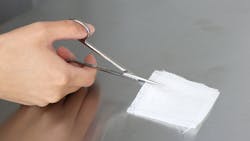Q: “One of my fellow workers will not use the non-latex material to test scissors. Instead, they use gauze. Is that acceptable?”
A:
Medical device reprocessing (MDR) departments have many types of scissors within their department. During a previous speaking engagement, I mentioned having begun as a sterilization orderly in 1975. They said, “Man, you’re old!” Laughter broke out in the room and the talk went on. Why did I bring that up? I was taught to test scissors in 1975 with gauze, and it is still an acceptable method of testing. So, in a way, I am “old!”
Based on my experience, one should use a proven method to test any medical device. To me, a proven method is one that has documentation supporting it. I use my critical thinking skills. First, I look to the original equipment manufacturer (OEM) for directions (they usually have reference backing the why), then standards or guidelines, and finally [peer] reviewed literature. I also look at the documents’ references. There are many textbooks and training manuals on the market about how to test medical devices, and some of them do not cite any sources for where they gained their information. Others just list general references that are hard to find and do not give specifics on where the information is to back the testing process.
ISO standard 7741:1986 Instruments for surgery—Scissors and shears—General requirements and test methods (first edition), describes using gauze as a method for testing them for sharpness. (ISO Standard, 1986).1
In a 1974 article written by George Pencer (yes, part of the original Snowden-Pencer famous combo), he makes the following statements. “Scissors, especially Mayo operating and Metzenbaum dissecting, which do not cut on the tip of the blades, can cause surgical havoc. Not only should a dissecting, or an operating scissor, cut tissue on the tips, but it is also important that the scissor blades glide over each other smoothly. Only a correctly ground scissor with properly set blades can provide this action. All operating Mayo and Metzenbaum scissors should cut four layers of gauze at the tip of the blades. Smaller scissors less than four inches in length should cut at least two layers of gauze at the tips. Additionally, eye scissors should have a delicate touch when cutting. The Mayo and Metzenbaum scissors should cut with a fine, smooth feel and a minimum amount of pressure by the blades. Check the action of the scissors; it should not be too tight or too loose. Check the tip (points) of the scissors. Are they too sharp? Are there burrs on the tips of the blades, especially on the Mayo and Metzenbaum scissors? When the scissors are closed, are the tips of the blades open? A scissor should both cut on the tips and feel very smooth when cutting.” (Device Technologies, 2023),2 (Pencer, 1974).3
“NOTE: A simple and effective test for scissors sharpness is to cut into a piece of ordinary absorbent cotton. The sharp scissors will cut cleanly all the way to the tips without folding the cotton in between the blades or pinching a small piece at the tips.” (Coates, 1980).4
This company’s IFU makes the following statement on testing scissors for sharpness. “Scissor blades glide smoothly from open to closed (they must not be loose when in the closed position). Test scissors by cutting thin gauze. Three-quarters of the length of the blade should cut all the way to the scissor tips, and not hang up.” (Roboz, 2023).5
Another popular company’s IFU on testing scissors says, “Check scissors blades to ensure proper function. Blades should glide open and closed smoothly. Test cutting performance at ¾ length of the blade with the following recommended materials. Scissors should cut all the way to the tips. Recommended cutting tests materials: Fine/Delicate scissors: Surgical glove; Medium scissors: single layer of stocking/cast netting; Large utility scissors: Double layer of stocking/cast netting.” (Miltex, 2005).6
It is up to the department to find something to test the scissors for sharpness. The question is, “With what?” In your situation, it seems non-latex is the testing material of choice. So, to answer the first part of your question, yes, gauze is an acceptable method.
In part two next month, we will examine the use of latex as a testing method for sharpness for scissors. I will also share a sample statement that I feel departments can use as part of their policy for testing scissors and other medical devices for functionality. Stay tuned!
References
1. ISO. (1986). ISO standard 7741:1986 Instruments for surgery—Scissors and shears—General requirements and test methods. (11th ed.) n.p. International Standard. https://www.iso.org/standard/14580.html.
2. Device Technologies. (2023). Snowden-Pencer. https://www.device.com.au/our-brands/Snowden.
3. Pencer, G. (1974). What you should know about surgical instruments. p. 44–45. Surgical & Diagnostic Exchange, Inc., (Reprinted from “What you should know about surgical instruments,” 1974, The Surgical Team, May–June 1974, 39–42; 45.
4. Coates, H. W. (Ed.). (1980). CARE AND HANDLING OF SURGICAL INSTRUMENTS (2nd ed., p. 21). American V. Mueller.
5. Roboz Surgical Instrument Co. (2023). Products: Bone Instruments. Roboz quality surgical instruments. http://www.roboz.com/bone.asp.
6. Miltex. (2005). Miltex Surgical Instruments Catalog [found under section 4D "Manual Cleaning”, n.p.]. York, PA, Miltex
About the Author

Stephen M. Kovach
Stephen M Kovach, BS, CFER, started in the medical field in 1975 as a sterilization orderly and has worked in many positions within the Healthcare Industry. He presently is Clinical Educator Emeritus at Healthmark, A Getinge company.

